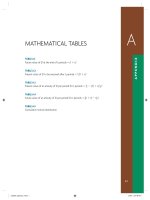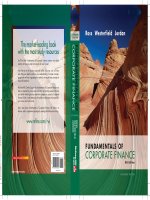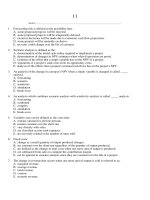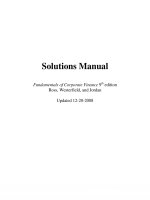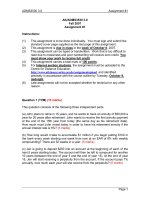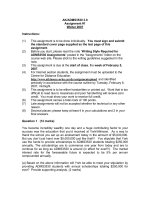exam solution 11 fundamentals of corporate finance, 4th edition brealey
Bạn đang xem bản rút gọn của tài liệu. Xem và tải ngay bản đầy đủ của tài liệu tại đây (27.1 KB, 9 trang )
Name
Section
ID #
Professor Alagurajah’s Section M (Thursdays, 4-7 pm), Professor Ho’s Sections R (Fridays,
2:30-5:30 pm) and S (Mondays, 2:30-5:30 pm), Professor King’s Sections P (Mondays, 710 pm) and O (Internet), Professor Kohen’s Section T (Wednesdays, 7-10 pm), Professor
Pestano’s Section Q (Wednesdays, 4-7 pm), and Professor Tahani’s Section N (Tuesdays,
7-10 pm).
AP/ADMS 3530.03 Finance Midterm Exam
Winter 2010
February 21, 2010
Exam – Type A
This exam consists of 30 multiple choice questions and carries a total of 100 points.
Choose the response which best answers each question. Circle your answer below, and
fill in your answers on the bubble sheet. Only the bubble sheet is used to determine
your exam score. Please do not forget to write your name and ID # both at the top of this
cover page and on the bubble sheet. Also please write the type of your exam (A or B)
on the bubble sheet.
Please note the following points:
1) Read the questions carefully and use your time efficiently.
2) Choose the answers that are closest to yours, because of possible
rounding.
3) Keep at least 4 decimal places in your calculations and final answers,
and at least 6 decimal places for interest rates.
4) The 20 “Numerical questions” are worth 4 points each.
5) The 10 “Conceptual questions” are worth 2 points each.
6) Unless otherwise stated, interest rates are annual, and bonds pay
semiannual coupons and have a face value (or par value) of $1,000.
7) You may use the back of the exam paper as your scrap paper.
1
Numerical questions (4 points each)
1. You want to buy a house that costs (before down payment) $450,000. You make a 10%
down payment and finance the rest with a 30-year mortgage. The mortgage has a five
year renewal term for which the annual mortgage rate is 5.20% (APR compounded
semi-annually). What will the remaining principal of the loan be at the end of the 5-year
term if you are making monthly payments?
A) $272,400
B) $310,450
C) $372,662
D) $372,947
E) $414,068
2. In four years from today, the following cash flow stream will have a future value of
$5,104.64: $100 today, $500 at the end of one year, $800 at the end of two years, “X”
at the end of three years, and $2,000 at the end of four years. The annual interest rate
is 6%. What is X?
A) $1,050
B) $1,200
C) $1,400
D) $1,484
E) $2,150
3. If $300,000 is borrowed for a home mortgage at a posted rate of 6.10% (APR semiannually compounded), how much interest can be saved over the life of the mortgage
by agreeing to a 20-year amortization period, rather than a 30-year amortization period?
Assume monthly payments and choose the closest answer.
A) $73,400
B) $82,824
C) $96,471
D) $110,715
E) $132,353
4. You are planning to set up a 30-year trust fund for your niece that will pay $5,000 at the
end of the first year and then the payments increase by 2.25% per year. The trust fund
will earn on average a 5.75% annual rate of return. How much money should you invest
today in order to provide the correct amount of funds to your niece?
2
A) $72,645
B) $90,811
C) $142,857
D) $156,980
E) $175,788
5. How much interest is to be earned between the end of Year 4 and the end of Year 6 on
a $7,500 deposit made today that earns 3.20% annual interest, compounded
semiannually?
A) $480.00
B) $483.84
C) $553.16
D) $558.21
E) $577.24
6. David deposits $1,500 in a 3-year term deposit that pays 4% interest with quarterly
compounding. At the end of three years, he transfers the amount to another 3-year term
deposit that pays 5% interest with monthly compounding. How much will he have 6
years from now?
A) $1,953
B) $1,963
C) $5,420
D) $6,234
E) $14,761
7. Richard wants to invest his money at the local bank. Which one of the five accounts
below is best for him?
I. APR of 5% with semiannual compounding
II. APR of 4.97% with quarterly compounding
III. APR of 4.89% with monthly compounding
IV. APR of 4.95% with weekly compounding
V. APR of 4.94% with daily compounding
A)
B)
C)
D)
E)
I
II
III
IV
V
3
8. Mr. Matsui plans to make the following annual contributions to his investment account
for the next 30 years:
Year
1
2
3
4
5
6 and thereafter
Amount ($)
5,000
4,000
6,000
7,000
3,000
8,000 per year
If the contributions are made at the end of each year, and the rate of interest is 5%, how
much money will he have at the end of 30 years?
A) $449,726.70
B) $467,527.50
C) $475,527.50
D) $480,212.43
E) $499,303.88
9. Maria Tiberini plans to retire soon, on her 65th birthday. She wonders if she has enough
money to support her retirement. Since she had a heart attack 3 years ago, she does
not expect she would live longer than 85 years old. She plans to spend $40,000 in the
first year of retirement. She expects her annual expenses will increase at the rate of
inflation, expected to be 2% per year. Assume that all expenses are paid at the
beginning of each year, how much money does she need at 65 to support her postretirement expenses? Assume that the rate of interest is 6%.
A) $458,797
B) $536,675
C) $539,386
D) $543,613
E) $568,875
10. Chris Little owes his friend some money. His friend gives him 5 options of payment. If
the rate of interest is 8%, which option should Chris choose?
I. Pay $2,100 today
II. Pay $500 per year, at the end of every year for 5 years
III. Pay $450 per year, at the beginning of each year for 6 years,
IV. Pay $500 at the end of year 1, $400 at the end of year 2, $300 at the end of year
3, and $1,500 at the end of year 4,
V. Pay $1,200 at the end of year 3 and $1,500 at the end of year 5
4
A) I
B) II
C) III
D) IV
E) V
Please use the following information to answer Questions 11 – 14.
In 2004, Target Ltd. issued $50 million worth of bonds at par with a coupon rate of 6%, with
semi-annual interest payments and a maturity of 10 years. In 2008, due to the credit
crunch, the yield to maturity of the Target bonds increased to 8%. In 2009, Buyer Corp.
announced a friendly takeover of Target Ltd. and the yield to maturity of the bonds
decreased to 7%.
11. What was the current yield of the bonds in 2008?
A) 3.5%
B) 4.4%
C) 6.0%
D) 6.6%
E) 8.0%
12. What was the price of the bonds in 2009?
A) $708.92
B) $918.89
C) $958.42
D) $977.43
E) $1020.24
13. What is the approximate rate of return for a bondholder who purchased the bonds in
2008 and sold them in 2009 if all coupons were spent?
A) 5.8%
B) 8.5%
C) 11.3%
D) 12.4%
E) 14.5%
5
14. In order to be able to pay the total face value back in 10 years, Target Ltd had decided
to use a sinking fund in which it will make semi-annual payments that would serve to
accumulate the total face value. The sinking fund pays an interest rate of 3%
compounded semi-annually. What is the total semi-annual cash outflow (including
coupon payments) for the company?
A) $1,500,000
B) $1,860,785
C) $2,162,287
D) $3,662,287
E) $4,860,785
15. What is the coupon rate for a bond with four years until maturity, semi-annual interest, a
face value of $1,000, a price of $1,035.10, and a yield to maturity of 6%?
A) 3.5%
B) 4.5%
C) 5.5%
D) 7.0%
E) 8.0%
16. You buy stock in ABC inc. today for $70. ABC expects to pay a $2 dividend next year,
no dividend in year 2 and a $5 dividend in year 3. You expect to sell it at the end of year
3 realizing an expected annual return of 0% annually. What is your rate of return over
the 3 year period?
A) Gain of 10%
B) Loss of 10%
C) Gain of 11.11%
D) Loss of 11.11%
E) There is no capital gain or loss
17. The expected EPS (earnings per share) of Kamal inc. is $5 and the company usually
retains 70% of its earnings. Kamal inc. has a discount rate of 16%, and a return on
equity (ROE) of 20%. What is Kamal inc. current stock price?
A) $31.25
B) $60.75
C) $70
D) $75
E) $250
6
18. A preferred stock has paid a $5 annual dividend since the company began. The stock
currently sells for $62.50. What might investors expect to pay for the stock six years
from now if the expected rate of return will stay at the same level?
A) $25.45
B) $33.00
C) $45.00
D) $62.50
E) $92.50
19. The dividends of XYZ corp. are forecasted to grow at 20% per year for two years, after
which the shares grow at a fixed rate of 6% forever. If the discount rate is 15% and a
dividend of $2.50 was just paid, what should be the current share price?
A) $31.16
B) $33.23
C) $37.42
D) $47.77
E) $50.61
20. What should be the annual dividend yield for Year 3 of a stock if a $5 dividend per share
was just paid, the stock has an annual required rate of return of 20%, and a constant
dividend growth rate of 6%?
A) 11%
B) 12%
C) 13%
D) 14%
E) 15%
Conceptual questions (2 points each)
21. You are the financial manager of BC Gold Corporation and are considering different
operating strategies for the coming year. From a financial management standpoint,
which of the following would be your optimal strategy?
A)
B)
C)
D)
E)
Undertake the plan that would reduce the overall riskiness of the firm.
Undertake the plan that would maximize the current stock price.
Undertake the plan that would result in the largest profits for the year.
Undertake the plan that would maximize your personal wealth.
Undertake the plan that would lead to the most stable stock price for the year.
7
22. Shareholders attempt to control managerial behavior by:
A) Electing the board of directors who select management.
B) The threat of a takeover by another firm.
C) Setting compensation contracts and tying compensation to corporate success.
D) A and B
E) A and C
23. In a capital budgeting decision, which of the following must be considered?
I. The size of the cash flows.
II. The timing of the cash flows.
III. The riskiness of the cash flows
A)
B)
C)
D)
E)
I only.
II only.
I and II only.
II and III only.
I, II and III.
24. A stream of equal cash payments equally spaced in time and lasting forever is termed:
A)
B)
C)
D)
E)
Perpetuity
Growing perpetuity
Annuity
Growing annuity
None of the above.
25. Which of the following is correct about corporate debt?
A) The risk of default is measured by bond ratings, with the higher the rating the
lower the risk of default.
B) Because debt holders do not own the firm, they normally have a voting power.
C) Since interest is an obligation, it cannot be treated as an expense and therefore
cannot be deducted from taxable income.
D) The fund established to retire the debt before its maturity date is called a mutual
fund.
E) None of the above statements are correct.
26. The market value of a firm's equity is determined by:
A) the difference between book values of assets and liabilities.
B) multiplying share price at issue by the number of shares issued.
8
C) multiplying share market price by the number of shares outstanding.
D) multiplying share market price by the number of shares authorized.
E) None of the above.
27. Which of the following statements best describes the real interest rate?
A) Real interest rates exceed inflation rates.
B) Real interest rates are always negative.
C) Real interest rates can be negative.
D) Real interest rates traditionally exceed nominal rates.
E) Real interest rates are always positive.
28. Which of the following is the most correct for a corporate bond, compared to a
government bond?
A)
B)
C)
D)
E)
The corporate bond will sell for a lower price.
The corporate bond will sell for a higher price.
The corporate bond will offer a lower coupon.
The corporate bond will offer a higher coupon.
The corporate bond has a higher credit spread.
29. Which of the following statements is correct?
A) All else equal, if a bond’s yield to maturity increases, its price will increase.
B) All else equal, if a bond’s yield to maturity increases, its current yield will fall.
C) If a bond’s yield to maturity exceeds the coupon rate, the bond will sell at a
premium.
D) All of the answers above are correct.
E) None of the answers above is correct.
30. A part of a bond agreement that limits certain actions of a firm in order to protect the
bondholders is known as:
A) Warrant.
B) Authorized debt.
C) Sinking fund.
D) Secured debt.
E) Protective covenant.
9

